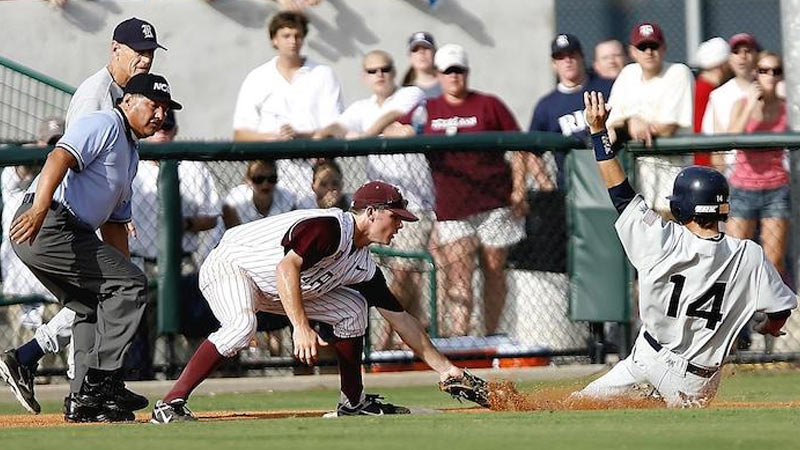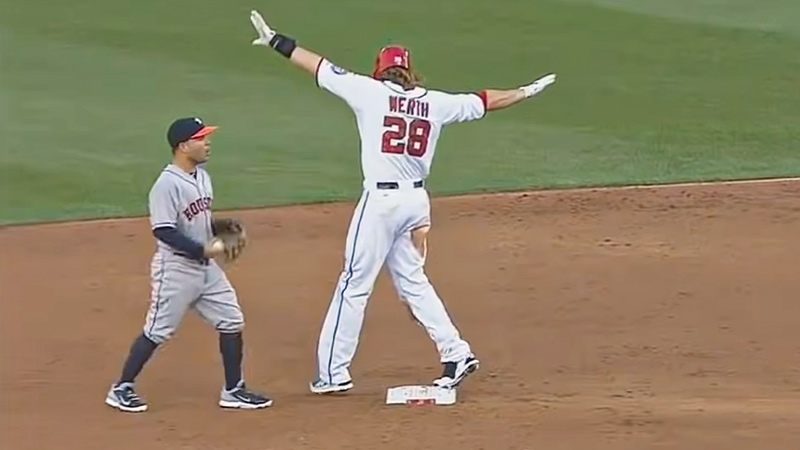Scoring is a fundamental aspect of baseball that determines the outcome of a game and measures the success of teams and individual players.
How scoring works in baseball is essential for fans and players alike.
In this comprehensive blog post, we delve into the intricacies of baseball scoring, exploring the role of innings, essential scoring facts, the components displayed on a baseball scoreboard, and the historical development of the scoring system.
Let’s unlock the secrets behind the numbers that shape America’s favorite pastime. So, stay calm and focused.
How Does Scoring Work In Baseball?
Scoring in baseball is a symphony of runs, rewarded when a player rounds the bases and reaches home plate. Hits, errors, and RBIs (Runs Batted In) compose the melodic notes of the score. Innings, dividing the game into nine harmonious parts, set the rhythm for the contest.
A baseball scoreboard harmonizes the score, outs, inning, and count, orchestrating the flow of information. The scoring system has evolved, fine-tuning its notations and harmonizing with technological advancements.
Baseball scoring allows fans to immerse themselves in the sonorous intricacies that shape the game, transforming it into a symphony of statistical splendor.
Role of Innings in Baseball Scoring
Innings serve as the building blocks of baseball scoring, dividing the game into nine parts for each team.
The concept of innings is crucial for comprehending how scoring works in baseball and determining the ultimate winner of the game. Each inning consists of two halves: the top half, where the visiting team bats, and the bottom half, where the home team bats.
The Structure of Innings
In a regulation baseball game, both teams have an opportunity to bat in each inning. The visiting team takes their turn to bat in the top half of the inning, attempting to score runs against the opposing team’s defense.
Once the visiting team records three outs, the teams switch positions, and the home team assumes the offensive role in the bottom half of the inning.
This process repeats for the full nine innings, except in the case of a tie game or extra innings, which extend the game until a winner is determined.
Determining the Winner
At the conclusion of the game, the team with the most runs is declared the winner. Runs represent the primary unit of scoring in baseball, earned when a player successfully crosses home plate after advancing through the bases.
Each team’s total runs scored throughout the game determine the outcome, emphasizing the importance of effective offense and defense throughout the nine innings.
Essential Facts That Matter in Scoring
While runs are the primary factor in determining the winner, several other key elements contribute to baseball scoring. These essential facts are essential for tracking and analyzing the game’s progression.

Source: baseballscouter.com
Hits
Hits occur when a batter safely reaches base after hitting a pitched ball and is a crucial statistic in scoring. Hits can be classified as singles, doubles, triples, or home runs, depending on how far the batter advances on the hit.
The number of hits a team accumulates can directly impact their ability to score runs.
Errors
Errors are defensive mistakes made by fielders that allow the batter or baserunners to reach base or advance.
Errors can occur during fielding, throwing, or catching the ball, and they provide opportunities for the opposing team to extend their offensive inning or score runs.
Errors can significantly influence the outcome of a game and are recorded as part of the scoring statistics.
RBIs (Runs Batted In)
RBIs are credited to a batter when their hit or out results in a run being scored. For example, if a batter hits a single and a teammate scores from a previous base, the batter is credited with an RBI.
RBIs showcase a player’s ability to contribute to the team’s scoring efforts and are an important metric in evaluating offensive performance.
The significance of runs, hits, errors, and RBIs provides a comprehensive view of how scoring is determined in baseball.
These essential factors collectively shape the outcome of a game, highlighting the interplay between offensive and defensive strategies and individual player performances.
What Is Shown on a Baseball Scoreboard?
A baseball scoreboard serves as a central hub of information for fans attending or watching a game. It displays essential details that allow spectators to stay engaged and informed throughout the game.
Here are the key elements typically shown on a baseball scoreboard:
Score
The scoreboard prominently shows the score of the game, indicating the number of runs each team has scored. The score is updated after each run is scored, providing fans with a real-time representation of the game’s progress.
Outs
The number of outs is another critical piece of information displayed on the scoreboard. It informs fans about how many batters the defensive team has retired. Typically, three outs are required to end an inning and switch sides.
Inning
The scoreboard indicates the current inning of the game. This helps fans keep track of the game’s progression and understand which team is currently at bat or in the field.
Count
The count represents the number of balls and strikes for the current batter. It is usually displayed in a numerical format, such as “Balls-Strikes.”
This information is crucial as it gives fans an idea of the current situation and can provide insight into the strategic decisions made by both the pitcher and the batter.
Additional Statistics
Scoreboards often feature other statistics to enhance the fan experience. These may include the number of hits, errors, and sometimes even more specific data like batting averages, on-base percentages, and pitchers’ earned run averages (ERAs). These statistics provide deeper insights into the game and player performance.
The History of the Baseball Scoring System

Source: tht.fangraphs.com
The baseball scoring system has evolved alongside the game itself, reflecting changes in scoring conventions and technological advancements.
In the early days of baseball, scoring methods were relatively basic, utilizing simple symbols and shorthand to track the flow of the game.
However, as the sport developed, standardized scoring systems emerged, allowing for more comprehensive and consistent notation.
Early Scoring Methods
In the early years of baseball, scoring was primarily done by hand using symbols and abbreviations in scorebooks. These scoring systems varied, and individual scorekeepers often developed their own shorthand notations.
However, the basic objective was to record the essential elements of the game, such as runs, outs, and player movements.
Standardized Scoring Systems
As baseball gained popularity and became more organized, standardized scoring systems began to emerge. The Chadwick Scoring System, developed by Henry Chadwick in the late 19th century, revolutionized scoring methods.
This system introduced standardized symbols and notations for various game situations, making it easier for scorekeepers and fans to follow the game’s progress.
Technological Advancements
With the advent of technology, the way baseball is scored and displayed has undergone significant transformations. Electronic scoreboards replaced manual ones, providing faster and more accurate updates on the score, outs, and other statistics.
Computerized scoring systems and digital displays allow for more sophisticated tracking of player and team performance, offering detailed statistics and instant updates.
The combination of standardized scoring systems and technological advancements has greatly enhanced the accuracy and accessibility of baseball scoring, enabling fans to have a richer understanding of the game’s intricacies.
FAQs
What is the difference between a run and an RBI in baseball?
A run is awarded when a player crosses home plate, while an RBI (Run Batted In) is credited to a batter when their hit or out results in a run being scored. RBIs represent a batter’s contribution to their team’s scoring.
How are errors scored in baseball?
When a fielder makes a mistake that allows the batter or baserunners to reach base or advance, it is recorded as an error. The fielder responsible for the error is charged with the mistake, and the batter’s at-bat is considered as reaching base on an error.
Can a player score a run without hitting the ball?
Yes, a player can score a run without hitting the ball. Baserunners can advance to subsequent bases through stolen bases, wild pitches, passed balls, and walks, among other methods. If they successfully reach home plate, they score a run.
How are pitching statistics calculated for individual pitchers?
Pitching statistics, such as earned run average (ERA), strikeouts, and wins or losses, are calculated based on the performance of individual pitchers. These statistics reflect their effectiveness, control, and overall performance on the mound.
How do tie games and extra innings affect scoring?
In the event of a tie game at the end of nine innings, extra innings are played until a team achieves a higher score. Scoring in extra innings follows the same principles as the regular nine innings, with each team having the opportunity to score runs and secure the win.
Bottom Line
So, how scoring works in baseball is crucial for both casual viewers and die-hard fans of the game. From runs and RBIs to errors and hits, the scoring system captures the essence of each play and determines the final outcome.
By unraveling the intricacies of baseball scoring, we gain a deeper appreciation for the statistical elements that make the sport so captivating.
So, next time you’re at a baseball game or following it from home, keep an eye on the scoreboard and witness the numbers come to life, telling the story of America’s beloved game. Best of luck.







